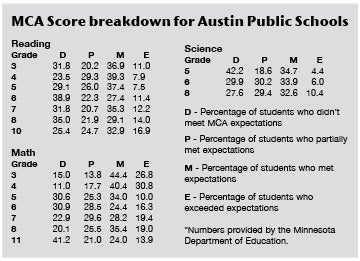State tests show Austin students down in reading; Math scores come in just below average
Published 10:30 am Wednesday, August 27, 2014
Although overall Minnesota students’ performance on state proficiency tests this year held largely steady or showed modest gains across grade levels for the state, Austin schools saw a decrease in scores for reading.
Results of the Minnesota Comprehensive Assessments — known as the MCAs — released this week by the state Department of Education show Austin students held steady in math, but dropped in reading.
“It appears as if on our math side we are pretty much on line with the state, we’re just slightly under the state average,” Educational Services Director John Alberts said. “So in terms of math we just have some minor things to be looking at there.”
Statewide, about 61 percent of students proved proficient in math, about the same as last year. In Austin, about 52.5 percent of students proved proficient in math, down a few percentage points from last year’s 54.6 percent. Reading statewide rose from 58 percent in 2013 to 59 percent, whereas Austin dropped a few points from 47.3 percent last year to 45.6 percent of proficient students.
Science scores statewide also rose — from 52 percent to 53 percent, whereas Austin showed only 40.7 percent of students were proficient.
The 2014 tests measured how students fared on their second attempt at a more rigorous reading test, which was introduced last year. Meanwhile, 11th graders faced a new math test, which also was considered more challenging. The tests measure students’ ability to meet reading, math and science benchmarks.
Statewide, the biggest leap was in fifth-grade reading, where proficiency climbed to 68 percent, 4 percentage points higher than last year. The state fared the best in third-grade math with about 72 percent of students considered proficient, a score unchanged from 2013. Yet the lowest scores were in eighth-grade science, where only 45 percent of students tested proficient, although it was up from last year by one point. Also coming in at the bottom was 11th-grade math. About 51 percent of students across the state were considered proficient on the new test, which state educators said will serve as the future baseline. In Austin, 37.9 percent of Austin students were proficient in the math score.
As shown by the dip in scores after the reading test was introduced in 2013, teachers and students will need time to adjust to the new math test, Education Commissioner Brenda Cassellius said.
“These are very tough tests that require higher order thinking,” she said.
Although Austin students were steady in math, this year’s reading scores dropped.
“We fell a couple of percentage points this year, which was unfortunate, and the state grew a couple percentage points,” Alberts said.
Last year, both the state and the school district fell due to a more rigorous assessment in reading, which had longer passages and a higher testing expectation.
“That’s one area we’re going to have to look at pretty specifically, and I think we’ll look at it in a couple different ways,” Alberts said.
Two big steps the district will look at is the curriculum alignment and sub-populations.
“To make sure that our curriculum that was purchased when the MCA two was around, is still in alignment, or if some adjustments need to be made around there, or if there’s things that we might be missing in terms of curriculum against what is being assessed,” Alberts said.
The district also found some of the sub-populations, such as non-white students or students who come from poverty, did not perform as well on the reading assessment as their peers. Alberts said those two categories will have a specific focus in the upcoming year.
One issue with the MCA tests is the timing on receiving the results. Because the tests are in the spring and the results aren’t released until about six months later, it is hard for individual teachers to use the data effectively. Instead, the district will use their fall benchmarking to look at what an individual student’s focus area should be.
“It’s just another piece of information that we’ll take along with other pieces of information like changing demographics, like ACT scores … like some of our benchmarking assessments, just to see where we’re at as a system,” Alberts said.
The district will also look for places where there are good successes, such as intervention with students to support them in math or reading.
“As we go into data we’ll look specifically at not just overall how students are doing but what sub-populations are doing, what buildings are doing, more so to see where are places in which success is occurring and how can we replicate that,” Alberts said. “There have been a number of different things put in place to help support in terms of interventions. As well, on the other side, where we have students that are highly able, we’re also considering how can we help push them as well.”
Much of this data work will be done throughout the school year. Two new things about the MCA this year include not having the MCA-Modified test, and switching all the tests to online only.
—The Associated Press contributed to this report.







